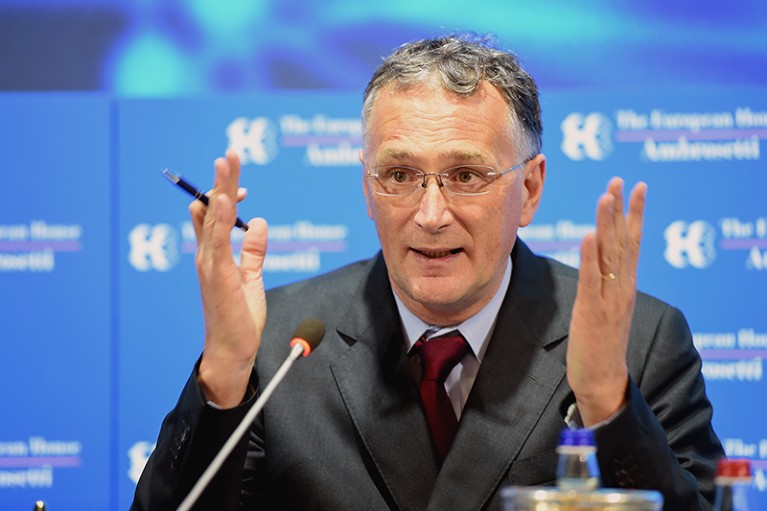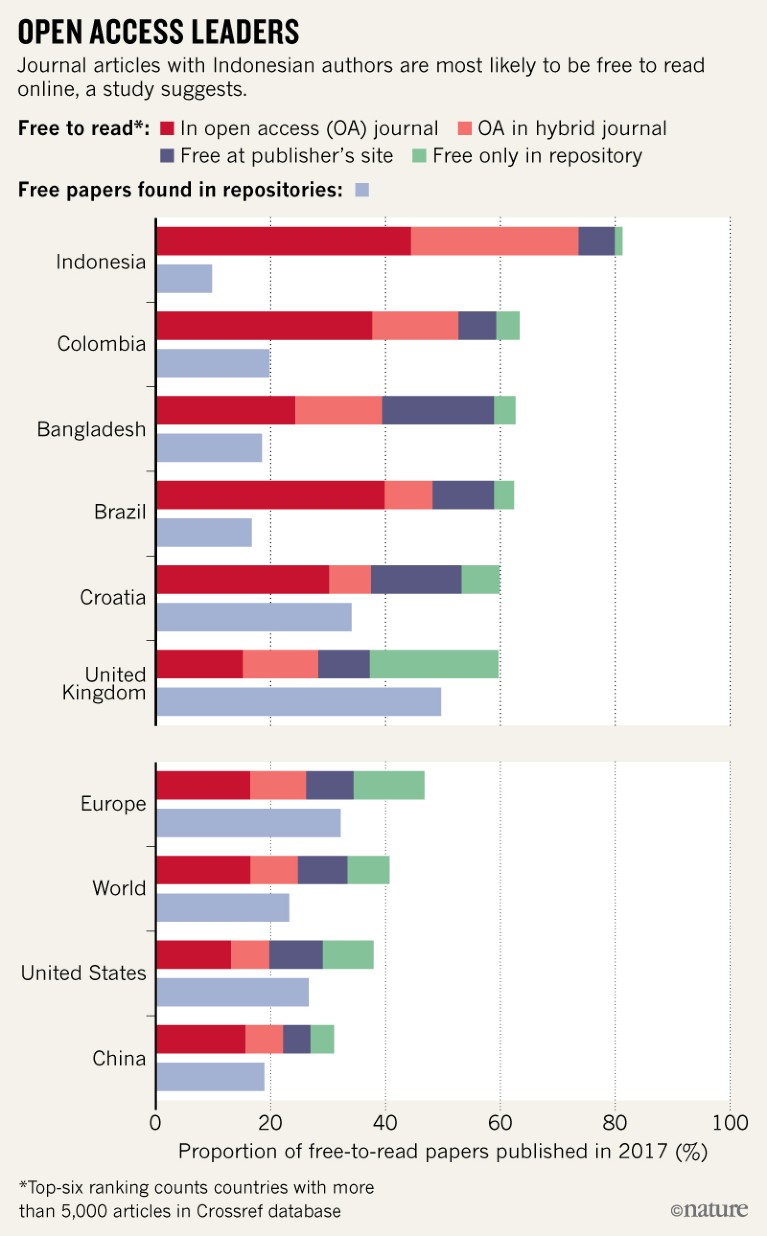EVENTS
Chang’e-4 finds hints of lunar mantle China’s Chang’e-4 mission to the far side of the Moon has detected minerals thought to have been excavated from deep beneath the lunar surface by an ancient asteroid. The spacecraft landed in the Von Kármán crater in January, marking the first time a probe has ever visited the Moon’s far side. In its first investigations, the mission’s Yutu-2 rover used a visible and near-infrared spectrometer to analyse the light reflected off the crater’s surface. Characteristic absorption patterns in the light, described in a paper in Nature this week, suggest the presence of the dense minerals olivine and low-calcium pyroxene, which are unlike any samples returned by previous probes and might originate from the lunar mantle. The authors say that the dense minerals might have been thrown out of the upper mantle during the event that created the basin. The material was probably scattered across the surface when another impact later created the nearby 72-kilometre-wide Finsen crater. The findings lend weight to the theory that the Moon’s surface was once molten but separated into layers as it solidified, burying denser minerals in the mantle.

The Yutu-2 rover.Credit: Xinhua/ZUMA
EVENTS
Terror attack Four Chinese researchers who were killed in the terror attacks in Sri Lanka last month were in the country as part of China’s Belt and Road Initiative (BRI), a vast infrastructure-building project that aims to connect China to other parts of the world. The researchers died when their hotel in Colombo was bombed on 21 April — one in a string of attacks that killed some 250 people. The four scientists were senior engineers Li Jian and Pan Wenliang of the South China Sea Institute of Oceanology in Guangzhou, and assistant researcher Li Dawei and doctoral student Wang Liwei of the First Institute of Oceanography in Qingdao. Five other Chinese researchers were also injured, according to the Chinese embassy in Colombo. The group had arrived in the city in mid-April, to work with local scientists at the China–Sri Lanka Joint Center for Research and Education at the University of Ruhuna, preparing for a research cruise on the Chinese ship Experiment 3. The joint cruise intended to study weather in the Indian Ocean and the geology of the sea bed. Although the ship has since left Colombo, it is unclear whether the research project will go ahead as planned.
POLICY
Primate research The US National Institutes of Health (NIH) would have to reduce its use of non-human primates in research, under a spending bill approved on 8 May by a committee in the US House of Representatives. The bill would direct the NIH “to accelerate efforts to reduce and replace the use of nonhuman primates with alternative research models” in its laboratories. If passed, it would apply to the 2020 budget year, which begins on 1 October 2019. The agency would also be required to produce a report on the number of primates it uses in research, its purpose for using them, how much pain they feel and a timeline for replacing and retiring the animals. To become law, the bill still needs to win approval from the full House, the Senate and President Donald Trump.
Sharing data The US National Institutes of Health (NIH) has negotiated an agreement with the Navajo Nation that will allow researchers on an agency-funded study to access health information from tribe members. The arrangement, announced on 7 May, does not cover genetic data or access to biological samples. But it will give scientists working on the Environmental Influences on Child Health Outcomes (ECHO) project — which tracks the long-term health of at least 50,000 children in the United States — access to some data from the Navajo Birth Cohort Study (NBCS). That study follows the children of about 1,600 Navajo parents from before birth, tracking how exposure to uranium and other pollutants from mining activities on Navajo reservations affects the kids’ development. ECHO researchers will be able to use NBCS data — such as levels of metal exposure — in their larger study.
Ebola vaccine With the number of Ebola cases surging in the Democratic Republic of the Congo, the World Health Organization (WHO) said on 7 May that it will revise its vaccination strategy. The WHO will change its dosing protocols to provide the rVSV-ZEBOV vaccine to more people. The dose given to people in high-risk groups will be halved from 1 millilitre to 0.5 ml — an amount that a clinical trial in Guinea found to be protective. People at lower risk will receive a dose of 0.2 ml. The WHO is also working with other organizations to roll out a second Ebola vaccine, developed by Johnson & Johnson. The organization estimates that as of 11 May, 1,680 people have been infected with Ebola during the current outbreak, and 1,117 of them have died.
PUBLISHING
Open access Academic publisher Springer Nature has proposed a way to make more research open access, which could pave the way to making papers free to read in Nature and Nature-branded research journals. (Nature’s news team is editorially independent of its publisher.) The idea is a response to ‘Plan S’, an initiative backed by a coalition of mainly European funders that aims to make all research it funds open access after January 2020. Springer Nature has suggested that it and other firms could be recognized as ‘transformative publishers’ — a title earned by increasing the average level of open-access primary research articles across all journals, providing greater transparency over open-access costs, and committing to making all papers open access at the end of an unspecified transition period. A Plan S spokesperson said they would not comment until the coalition releases updated implementation guidelines later this month.
PEOPLE
ERC president Nanobiologist Mauro Ferrari will become president of the European Research Council (ERC), the European Union’s premier funder of basic research, the ERC announced on 14 May. The European Commission selected him from a shortlist drawn up by a search committee nominated by research commissioner Carlos Moedas. Ferrari, who is 59, was born in Italy and has spent most of his research career in the United States, most recently as president and chief executive of the Houston Methodist Research Institute in Texas. He has a background in mathematics, mechanical engineering and medicine. He will take over in January 2020 from mathematician Jean-Pierre Bourguignon, who has been ERC president since 2014.

Mauro Ferrari.Credit: Pier Marco Tacca/Getty
Nuke deal falters Iran has threatened to renege on some of its commitments under a 2015 international agreement designed to ensure that the country’s nuclear activities remain peaceful. The United States pulled out of the deal, known as the Joint Comprehensive Plan of Action (JCPOA), this time last year and reimposed economic sanctions. The other parties to the deal continue to support it. Iran will initially only cease to abide by agreed limits on its stockpiles of low-enriched uranium and heavy water. But the country stated on 8 May that it would take more serious action within 60 days, unless the other parties enable it to continue oil exports and trade — in particular for medical supplies and food — despite US sanctions. Iran threatened to resume building the unfinished heavy-water nuclear reactor near Arak and to enrich uranium beyond the JCPOA limit.
SPACE
Space race Blue Origin, the space-flight company founded by US billionaire Jeff Bezos, unveiled its design for a Moon lander on 9 May and said that a larger version would be capable of taking astronauts both to and from the lunar surface. At a promotional event in Washington DC, Bezos also described the liquid-propellant rocket engine that Blue Origin is developing for lunar payloads. The company in Kent, Washington, is best known for its reusable suborbital-rocket system, which has taken scientific experiments to the edge of space and back. Blue Origin is one of several companies hoping to be involved in NASA’s goal to return astronauts to the Moon’s surface by 2024.
TREND WATCH
Some countries in southeast Asia, Africa and South America are leading the way in open access (OA) publishing, according to a preliminary analysis of millions of articles in the Crossref database that has been shared with Nature.
Indonesia publishes the greatest proportion of its papers OA, according to the study: some 81% of more than 20,000 journal articles with an Indonesian-affiliated author were available to read for free somewhere online, and 74% had an OA licence, so could legally be redistributed.
More than 60% of papers from authors in Colombia, Bangladesh and Brazil were free to read. Other nations with a smaller output — fewer than 3,000 papers each — also score highly on OA proportion, including Nepal and Peru. They surpass the leading European nations — Croatia and the United Kingdom — and the 2017 world average of 41%.
Heather Piwowar of the non-profit organization Impactstory in Vancouver, Canada, did the study with the ‘Unpaywall’ tool, which finds free-to-read versions of articles online.
The countries that score highly probably do so well because of their low-cost OA journals and websites, often supported financially by governments.

Source: H. Piwowar, using Unpaywall, Crossref, Microsoft Academic Search & GRID



